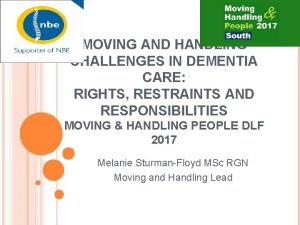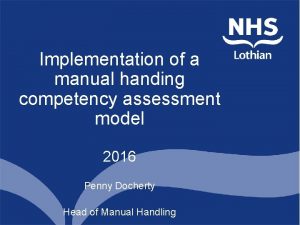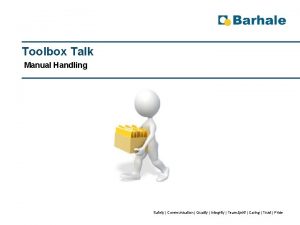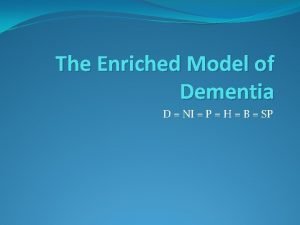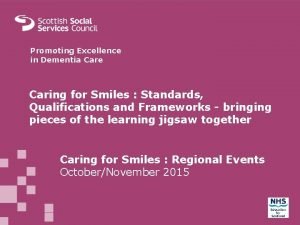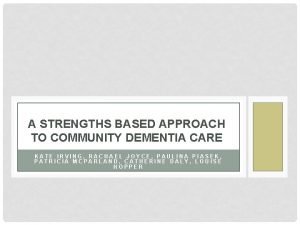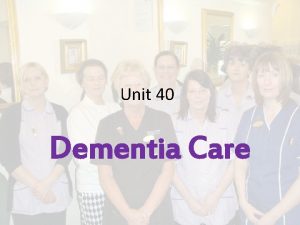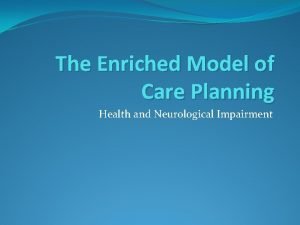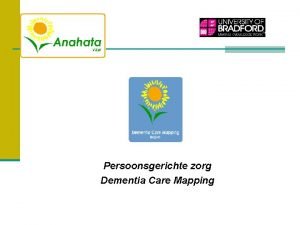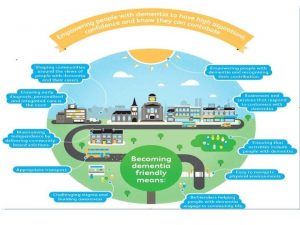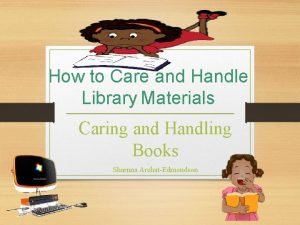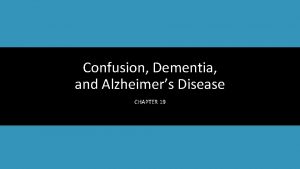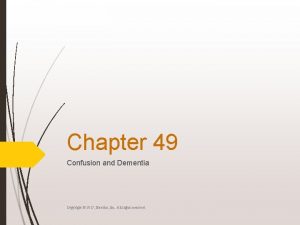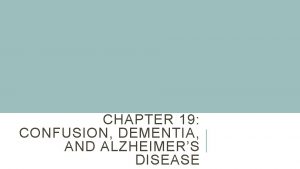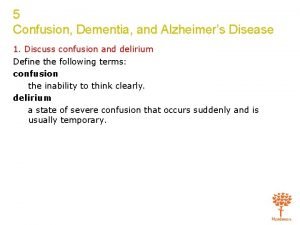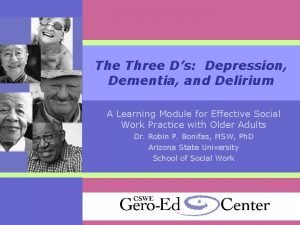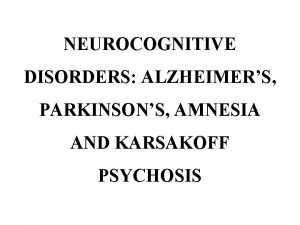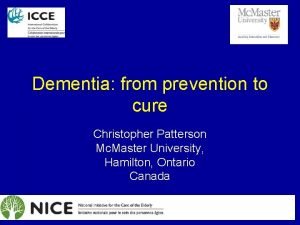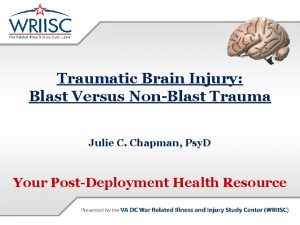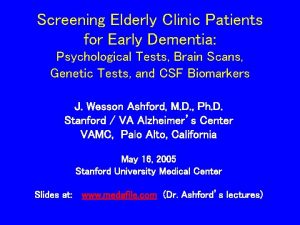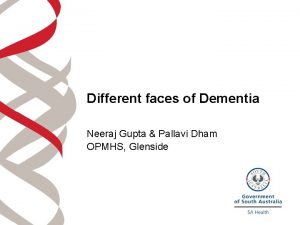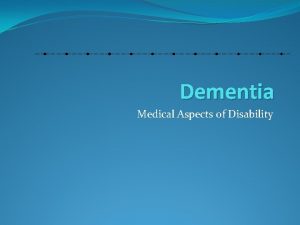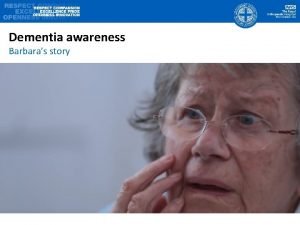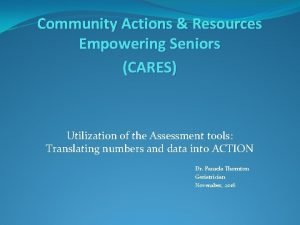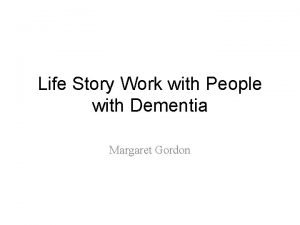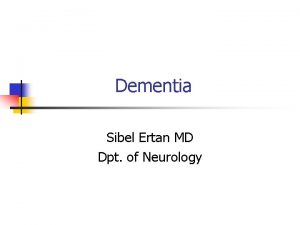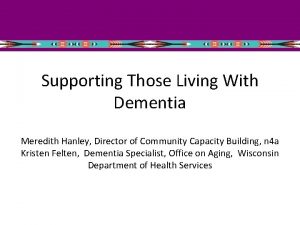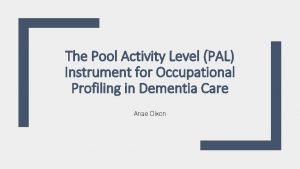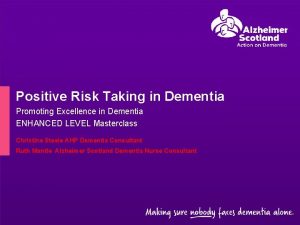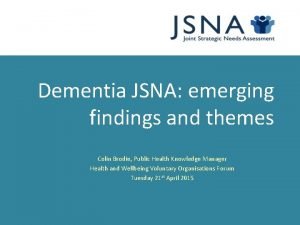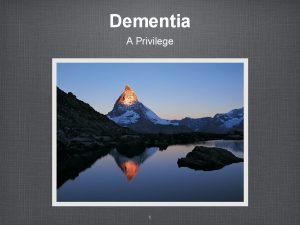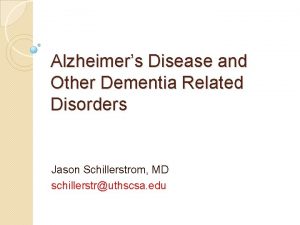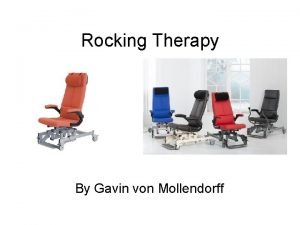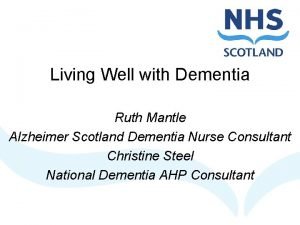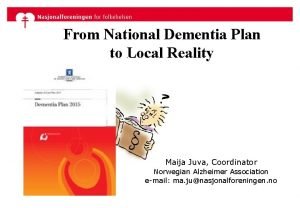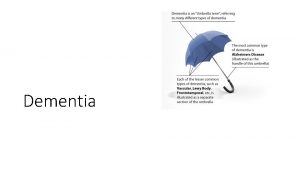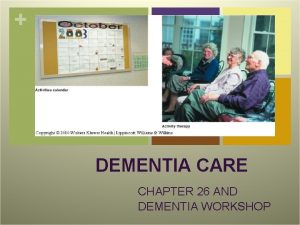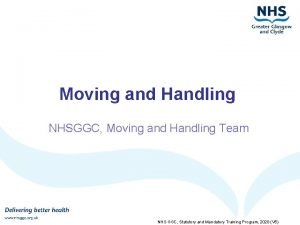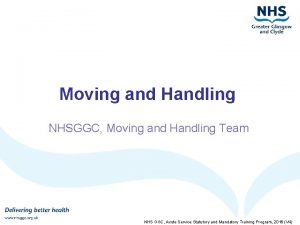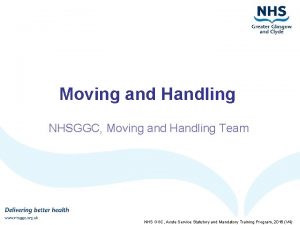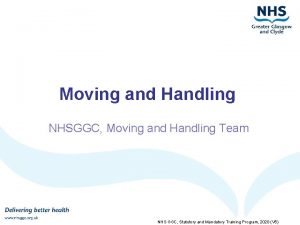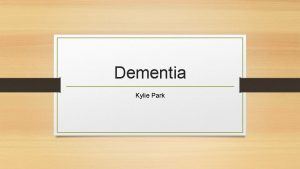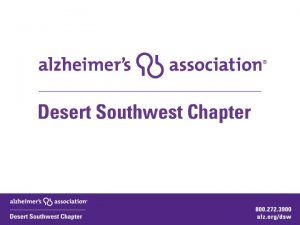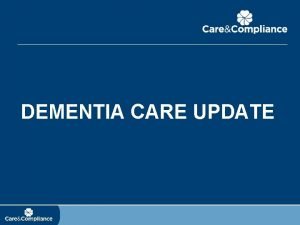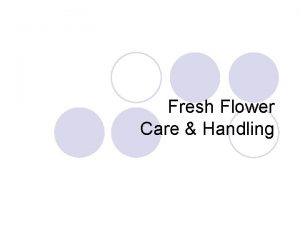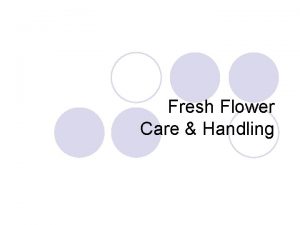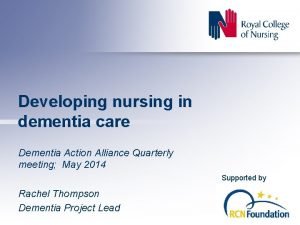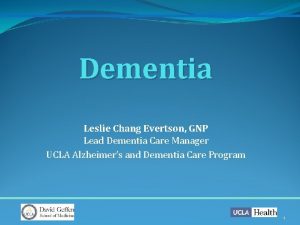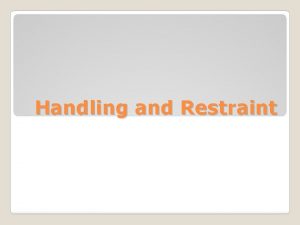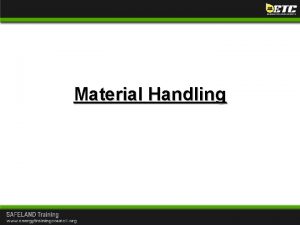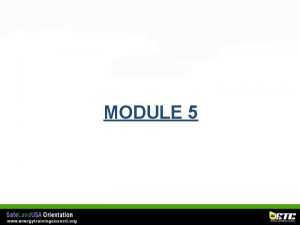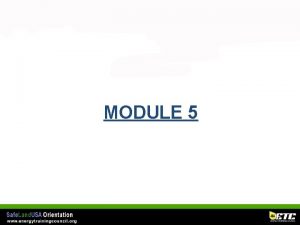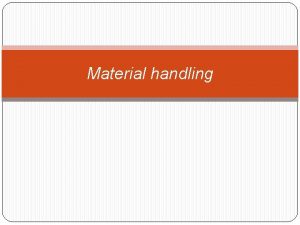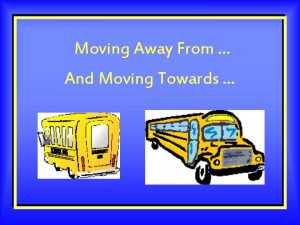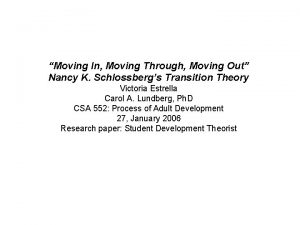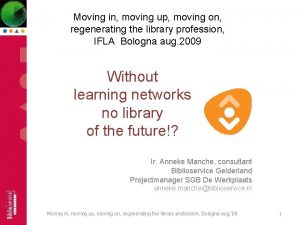MOVING AND HANDLING CHALLENGES IN DEMENTIA CARE RIGHTS



























































- Slides: 59

MOVING AND HANDLING CHALLENGES IN DEMENTIA CARE: RIGHTS, RESTRAINTS AND RESPONSIBILITIES MOVING & HANDLING PEOPLE DLF 2017 Melanie Sturman-Floyd MSc RGN Moving and Handling Lead

AIMS AND OBJECTIVES In this session the learner will be able to: 1. Be aware of dementia statistics 2. Be aware of incidents related to distressful behaviours. 3. Understand difference between challenging behaviour and distressful behaviours. 4. What are behaviours. 5. Identify behaviours. 6. Identify appropriate strategies to manage distress. 7. List legal responsibilities 8. List appropriate and inappropriate practices.

DEMENTIA STATISTICS In the UK there approximately, 800, 000 people diagnosed with dementia. (Alzheimer’s Society 2016) Current cost to health and social care £ 23 million and expected to rise to £ 27 million by 2018 (Alzheimer’s Society 2016) 80% of people living in residential and nursing homes are diagnosed with dementia (Alzheimer’s Society 2013).

VIOLENCE AND AGGRESSION Health and social care staff are often exposed to violence and aggression in the work place. Increased risk of injury to employees working with individuals who have dementia/LD/Mental health (Berry 2010, Skills for Care 2013). Risk of injury is foreseeable so organisations need to put steps into place to manage the risks.

VIOLENCE AND AGGRESSION Aggression and violence are terms often used interchangeably; however, the two differ. Violence can be defined as the use of physical force with the intent to injure another person or destroy property. Aggression is generally defined as angry or violent feelings or behaviour

INJURIES REPORTED TO HSE

LEGAL CASE 2011 Norfolk County Council care home. Carer sustained an arm injury after being punched and pulled by an elderly resident. Claimant won the case on the basis there were insufficient systems in place to protect the employee from injury. Lack of risk assessment identifying behaviour. Insufficient training to manage risks and protect employee. Overall legal costs and compensation £ 60, 000

IS IT CHALLENGING BEHAVIOUR? Commonly used terms in health and social care: Challenging behaviour Behaviour that challenges Harmful behaviour Distressful behaviour

DEFINITION OF BEHAVIOUR "culturally abnormal behaviour(s) of such intensity, frequency or duration that the physical safety of the person or others is placed in serious jeopardy (wiki) OR Any non-verbal, verbal or physical behaviour by a person which makes it difficult to deliver good quality care (NHS Protect).

WHAT IS A BEHAVIOUR? Behaviour is a response to an action, environment, stimulus or a person. Example if a stranger grabbed you, how would you respond? Reasons Although some times challenging the behaviour is usually for a reason.

TYPES OF NON-VERBAL BEHAVIOUR Agitation Facial expressions Intimidating body posture Cornering Invading body space Declining to move Passivity Walking Following someone

TYPES OF VERBAL BEHAVIOUR Talking loudly Swearing Crying Repetitive statements Repetitively asking questions Making personal comments Racist speech

TYPES OF PHYSICAL BEHAVIOUR Kicking Hitting Punching Grabbing Pushing Undressing Self harm Absconding Non-compliance Spitting Hair pulling

REASONS FOR CHALLENGING BEHAVIOUR Always a reason for behaviour Usually behaviour is a response to: Environment Person Stimulus Distress

TEMPERAMENTAL FACTORS High intensity of emotional responding Poor adaptability to new situations Sudden changes of movement and directions Reaction to other patient/residents distress

BIOLOGICAL OR PHYSICAL FACTORS Organic brain dysfunctions Poor sleep Hearing Difficulties Visual Difficulties Pain Parkinson’s Disease Dementia Learning Disability Drug or alcohol related Psychosis or personality disorder

SOCIAL FACTORS Poor quality care Care tasks Pre operative period Post surgery Rejection Environments Learning histories Lack of staff engagement Cultural, gender preferences

EMOTIONAL FACTORS Experiences of failure Dependency on others Poor self-esteem Unmet needs, toilet, pain, thirst Lack of meaningful activities

COGNITIVE FACTORS Poor problem-solving skills Poor communication skills Inability to remember new information/instructions Poor social skills Boredom Fear Memory loss Frustration

EXAMPLES OF BEHAVIOURAL TRIGGERS Turning in bed Getting out of bed a different side Lighting causing shadows Colour – staff clothing and environmental Race Gender Not having face to face transfer Inability to push down on arms of chair Communication Direction of movement Fear

BEHAVIOURAL TRACKING OR MONITORING What is the “ABC” Approach A = Antecedent B = Behaviour C = Consequence Action and Review

THE ‘ABC’ APPROACH Understanding what is a behaviour Understanding and identifying the antecedent. (Be Specific) Documenting the behaviour, (hit, grab, verbal) Managing the consequences Who was affected.

TRIGGERS/ANTECEDENTS Often behaviour comes with a warning. Sometimes there is no warning. Easiest approach is to observe, identify what is happening at the time behaviour is expressed. Behavioural distress is inventible in health and social care and organisations are expected to have systems in place to manage distress and reduce risk of injury/harm to patient and staff.

LOOK OUT FOR PRECURSORS Sometimes behaviour can occur without warning and should try and identify precursors Examples: Tense facial expressions Walking Body tension Increased breathing Refusal to communicate Not having eye contact or prolonged eye contact Threats Gestures

STRATEGIES De-Escalation Do nothing Leave and return Better understanding Observations – recording Physical intervention

LEGAL FRAMEWORK Common Law Equality Act 2010 Human Rights Act 1998 The Mental Health Act 1983 (amended 2007) The Mental Capacity Act 2005 Deprivation of Liberty Safeguards Health and Safety at Work Act Manual Handling Operations Regulations

DOLS – DEPRIVATION OF LIBERTY SAFEGUARDS The Mental Capacity Act allows restraint and restrictions to be used – but only if they are in a person's best interests. Extra safeguards are needed if the restrictions and restraint used will deprive a person of their liberty. These are called the Deprivation of Liberty Safeguards. The Deprivation of Liberty Safeguards can only be used if the person will be deprived of their liberty in a care home or hospital. In other settings the Court of Protection can authorise a deprivation of liberty. Care homes or hospitals must ask a local authority if they can deprive a person of their liberty. This is called requesting a standard authorisation.

OFFICE OF PUBLIC GUARDIAN (OPG) Protects people who may not have the mental capacity to make certain decisions for themselves, such as about their health and finance. taking action where there are concerns about an attorney or deputy registering lasting and enduring powers of attorney, so that people can choose who they want to make decisions for them maintaining the public register of deputies and people who have been given lasting and enduring powers of attorney supervising deputies appointed by the Court of Protection, and making sure they carry out their work in line with Mental Capacity Act looking into reports of abuse against registered attorneys or deputies

UNDERSTANDING INTERVENTIONS/RESTRAINT What is restraint? What is intervention? Should restraint or interventions be used are there other ways? De-escalation Minimal and safe interventions

ACCEPTABLE INTERVENTIONS Resident/patient may ask for bed rails because they are afraid of falling out of bed. Care homes/wards may have code access to doors to prevent residents, who lack capacity from entering. Care staff may sometimes have to decide quickly to restrain/safe hold if there is a risk of physical harm to themselves, the resident or others.

UNACCEPTABLE INTERVENTIONS Holding a resident/patient down physically or stopping them from doing something they want to do. Using wheelchair safety strap without risk assessment. Using bed rails without risk assessment. Using a tilt and space chair to stop someone from moving in a chair rather than postural management.

UNINTENTIONAL INTERVENTIONS Use of chairs that are too low or deep and prevent a person from transferring independently. Using a bed that is too low or high for someone to transfer independently.

OTHER EXAMPLES OF INTERVENTION Physical – 1 or more employees holding the resident, blocking the movement. Mechanical – use of bed rails and safety straps. Technological – use of door alarms, pressure pads, tagging. Chemical – inappropriate use of prescribed/over counter medication. Psychological – depriving choice, constantly telling resident not to do something.

LAWFUL INTERVENTION Intervention is only lawful if its use is: 1) Reasonable 2) Proportionate 3) Necessary 4) No more intervention than is necessary in the circumstances 5) Least restrictive option to be used and for shortest time necessary Used if threat to people or property

CAN YOU JUSTIFY INTERVENTIONS? Can you justify why interventions are required? Are you making a decision in the person’s best interest?

ARE INTERVENTIONS NECESSARY? Do you need to use interventions? Consider is there a risk to yourself, resident/patient or other people. Balance duty of care versus neglect. Any intervention should be used in the minimalist way possible and for the shortest time possible, (Sturman. Floyd 2013)

WHAT IS REASONABLE? Is the level of intervention reasonable to be used on an older person with dementia or someone with tissue viability, arthritic conditions? Have you considered the risk of bruising, fracture and possible skin damage?

INAPPROPRIATE MANAGEMENT Holding a resident/patient down physically or stopping them from doing something they want to do. Using wheelchair safety strap without risk assessment. Using bed rails without risk assessment. Using a tilt and space chair to stop someone from moving in a chair rather than postural management. High level of force

CONSEQUENCES OF NOT ADDRESSING CHALLENGING BEHAVIOUR Ineffective delivery of care Over reliance of anti-psychotic behaviour Increase in staff and patient injuries Reductions in staffing Higher staff turnover Managing training resources Failure legal duty to protect staff and patients from harm. Increased complaints and litigation Unmet care needs

SAFE MOVING AND HANDLING Use appropriate moving and handling equipment. Do not use a stand aid as a mechanical “drag” lift. May need to use in-chair sling. Use of bed rails. Use of in-bed positioning systems, i. e. Wendy Lett.

FRONT ASSIST TRANSFERS


COCOON METHOD

TURNING WITHIN BED

OVAL GLIDE BOARDS TO FIT SLINGS

TURNING IN BED Lift turn sheets Twin sheet/Topsheet/Wendy Lett

POSTURE MANAGEMENT Look at appropriate seating – is it correct height to facilitate standing, postural support, lateral support Contractures – increase pain, is this a trigger? Consider sleep systems, pillows, wedges.

DIFFICULTIES WITH HOISTING NRLS – identified 15 incidents where individuals have come to harm following a fall from a sling. Hoisting can be traumatic for individuals. What are the triggers for distress? Pain Incorrect sling Spreader bar Changes of positions Repetitive hoisting

DO YOU STILL SEE THIS?

GENERIC RISK ASSESSMENT Falls are foreseeable and steps should be put into place to manage risks. Completion of generic risk assessment for all tasks helping person up from the floor. Dependency Equipment Number of Any actions to options staff/handlers consider Independent Backward chaining 1 Behaviour, compliance, mobility, function, size, shape Need Assistance 2 -chairs Mangar Elk Mangar Camel Raizer Stand Up 1 -2 Behaviour, compliance, mobility, function, size, shape Dependence Hoist 2 -3 Behaviour, compliance, mobility, function, size, shape

MANGAR CAMEL Criteria Functional Independence Measure Useful for people who have 3 behavioural challenges Person does not have to be fully compliant Person can be rolled onto Camel Person can be slide onto Camel Does not need sitting balance or trunk control Benner Competent

RAIZER CHAIR BY LIFT UP/AAT Criteria Functional Benner MOBILITY Independence Measure Useful for people who have 2 -3 behavioural challenges Person does not have to be fully compliant Does not need sitting balance or trunk control Reduction of moving and handling Person does not need to be rolled Person can be quite passive Least disruptive 1 handler Competent

SUPPORTING FROM THE FLOOR

HOISTING SOLUTIONS Think of sling – is it a trigger for pain and discomfort? Fabric for ease of fitting and comfort Style of sling Spreader bar – width, type In-chair style sling Repetitive hoisting – care home minimum interventions in a 12 hour day 22 -24 (Sturman 2017).

WHAT IS REASONABLE? Elderly client with severe dementia Does try to scratch herself and carers Constantly calling out, shouting and kicks out Having bed care How long should someone go without any personal care or change of pad? Balance duty of care and neglect. What is reasonable? Is it justifiable? Is it necessary and proportionate?

INTERVENTIONS Established no MC Best interest decision – GP, family, carers, home manager. What is reasonable force? Use of mittens to cover hands. Use of pillow or duvet to cover hands. Possible use of bed rails and bumpers during handling tasks as long as carers posture not flexed. Give soft object to hold Use of permanent in bed positioning system to reduce manual handling interventions.

CASE STUDY 80 year old resident in care home with pressure ulcer grade 4 Community Nurses have provided high level dynamic mattress and advised care staff to turn the resident every 2 hours. Care staff report difficulties with turning during the night due to distressful behaviours.

STRATEGIES TO REDUCE RISK OF DISTRESS. Is it necessary to turn the resident every two hours when she is on a dynamic mattress? Would in-bed positioning systems reduce the risk of distressful behaviours? Introduction of lateral turning systems – TOTO or lateral turning mattresses.

Thank you for listening to my seminar. My contact details are: melanie. sturman@norfolk. gov. uk
 Moving and handling dementia patients
Moving and handling dementia patients Moving and handling competency assessment template
Moving and handling competency assessment template Manual handling tool box talk
Manual handling tool box talk Enriched model of care social psychology
Enriched model of care social psychology Tom kitwood enriched model of dementia care
Tom kitwood enriched model of dementia care Promoting excellence in dementia care
Promoting excellence in dementia care Dementia capable care
Dementia capable care Strength based dementia care
Strength based dementia care Unit 40 health and social care
Unit 40 health and social care Enriched model of dementia care
Enriched model of dementia care Dementie
Dementie Dementia care in bath
Dementia care in bath Negative rights vs positive rights
Negative rights vs positive rights Characteristics of rights
Characteristics of rights Legal rights vs moral rights
Legal rights vs moral rights Positive rights and negative rights
Positive rights and negative rights Primary secondary tertiary care nursing
Primary secondary tertiary care nursing Handling information in care settings
Handling information in care settings Use and care of the library
Use and care of the library Chapter 2 camera handling care and support
Chapter 2 camera handling care and support Littoral rights
Littoral rights Positive vs negative rights
Positive vs negative rights Negative rights
Negative rights Negative right
Negative right 3 zones of space and awareness dementia
3 zones of space and awareness dementia Confusion dementia and alzheimer disease chapter 19
Confusion dementia and alzheimer disease chapter 19 Chapter 49 confusion and dementia
Chapter 49 confusion and dementia Chapter 19 confusion dementia and alzheimer's disease
Chapter 19 confusion dementia and alzheimer's disease Confusion dementia and alzheimer's disease
Confusion dementia and alzheimer's disease If a resident with ad shows violent behavior the na should
If a resident with ad shows violent behavior the na should Difference between dementia and delirium
Difference between dementia and delirium Francisco fernandez md
Francisco fernandez md Types of amnesia
Types of amnesia Dementia treatments and interventions near patterson
Dementia treatments and interventions near patterson Dementia bookcase analogy
Dementia bookcase analogy Dementia pugilistica
Dementia pugilistica Latragenic
Latragenic Dementia 2015
Dementia 2015 Reversible dementia
Reversible dementia Epilepsy
Epilepsy Barbara's story dementia
Barbara's story dementia Alzheimers fast score
Alzheimers fast score Hearing impairment disability
Hearing impairment disability Fast score hospice
Fast score hospice Life story work dementia
Life story work dementia Dementia ddx
Dementia ddx Meredith hanley
Meredith hanley Rarly signs of dementia
Rarly signs of dementia Pal assessment tool
Pal assessment tool Symptoms of dementia
Symptoms of dementia Positive risk-taking dementia
Positive risk-taking dementia Alzheimer's dementia
Alzheimer's dementia Dementia
Dementia Alzheimers society contented dementia
Alzheimers society contented dementia Frontotemporal dementia
Frontotemporal dementia Rocking chair therapy for dementia patients
Rocking chair therapy for dementia patients Dementia
Dementia Parkinson triad
Parkinson triad Living well with dementia scotland
Living well with dementia scotland Dementia
Dementia
